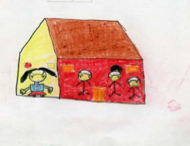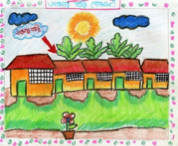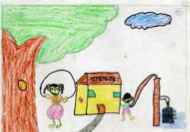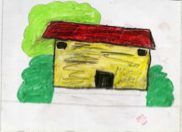Minushree Sharma, PhD (National University of Singapore)
minushree.s@ntucfirstcampus.com
NEOS Issue 15, Volume 2, Fall 2023
Return to Current Issue Table of Contents
The pavement- and slum-living children of India have received enormous attention from academic researchers, government bodies, non-government organizations (NGOs), and media. Studies on poor children have often focused primarily on their problems, but to understand the lived experiences of children beyond their problems, it is important to encourage children’s participation in the research process. This study explored how pavement- and slum-living children expressed their views on what they consider their home using rights-based participatory techniques such as drawings, which facilitate children to share their views and experiences with adults and each other.
The rights-based participatory framework helps to access children’s perspectives based on their personal experiences and the circumstances in their lives. Children are encouraged to choose the methods which are suitable to them. This helps provide relevant evidence about their present conditions, facilitating more impactful research (Pain 2004). Findings from such studies are likely to challenge policies that see children solely as future citizens (Morrow 2001; Bessell 2006; Cahill and Hart 2006).
After the 1989 United Nations Convention on the Rights of the Child (UNCRC), there has been a paradigm shift leading to a greater recognition of children’s rights. This has resulted in children’s increased participation in research, which has shown to be more advantageous rather than being restrictive to the research process (Lansdown 2005). Drawing on the framework of the UNCRC, informed by the idea of children as social actors (James et al. 1998), and valuing the children’s lived experience, this study was conducted among the pavement- and slum-living children in Kalighat, Kolkata, India, using rights-based participatory methodology.
Rights-based research with children applies the theoretical framework that constructs them as subjects with rights and as active social agents with the ability to understand their own lives and associate meaning to it. According to Beazley et al., the approach to rights-based research with children has five key characteristics:
First, it is genuinely respectful of children’s partnership and participation in research which must be meaningful on their own terms rather than being dictated by adult researchers or strictures of funding arrangement. Children’s perspectives and opinions must be integral to the research. Second, the approach places ethics at the heart of research and children must engage in research voluntarily and not be harmed or exploited through their participation. Third, the research conducted should be scientifically valid and conform to high scientific standards. Fourth, analysis must be robust, where possible combining both statistical and descriptive techniques. Finally, the research prioritises local knowledge and expertise to produce insightful information on children’s own experiences and opinions. (2011, 161)
I conducted this study as part of my PhD field research with an NGO providing primary education and other care services to pavement and slum-living children in Kolkata. I worked as a volunteer teacher, allowing me access to the children and the community. I tried to balance the power relationship and positioned myself as a friendly, native researcher who could speak their language and did not offer any false hopes to the children. A total of 70 participants, ages seven to seventeen, participated in the research. The majority of children lived with their parents or grandparents. This study used a multi-method approach, including participant observation, written methods, such as diaries and essays by older children, visual methods, such as drawings and photos taken by the children, and group discussions. Using various methods enriched the data and allowed cross-checking between methods.
Drawing was popular among children of all ages. Children were asked to draw their home and future aspirations. Some children who would talk less and did not actively participate in discussion could express their feelings through their drawings. Children came up with interesting insights about their drawings, which were also recorded. These qualitative comments were categorized into themes to understand the drawings better and provided stimulus for group discussion. Listening to what children say about their drawings is a significant aspect of this method, without which adults are liable to misinterpret what the child has represented.
Kalighat is home to many poor people. It is a place famous for the Kali temple, and pilgrims from different parts of the country visit this area. There are poor people living all around the area, either on the street pavements or just outside the temple. Many of them are living on the pavement with their children, having once inhabited a slum that the government demolished. Most people living on the pavement or in nearby slums have migrated from villages in search of job opportunities. In the life of pavement – and slum-living children of Kalighat, everyday spaces such as the ‘pavement,’ ‘slum,’ and ‘NGO centers’ are significant in both positive and negative ways. These spaces in the children’s lives invoke powerful feelings associated with belonging, exclusion, safety, and danger. The street also offers children the possibility of demonstrating agency and building cultural capital through understanding and interaction with their local social environment (Skelton 2000).
The children living on the pavements and in the slum considered the pavement to be their ‘home’ and preferred to spend most of their time there. Children would often point to fixed places in the street when asked about their house/home – such as outside a particular shop or behind a lamppost. They preferred working and living in the Kalighat area as compared to the other parts of the city and their village. The most common reason cited by them for their satisfaction within this area was the potential sources of income; its status as a pilgrimage center provided the children and their families with more ready opportunities for work.
When the children were asked to draw their homes, most drew proper sheltered houses with overhead roofs and surrounding gardens. On being probed, most responded that they drew their future house, which they aspire to build for their parents and for themselves to stay comfortable. Some children drew their village house. This is similar to Beazley’s (2000) findings, where the street children of Yogyakarta were asked to draw the maps of their hometowns or villages, which showed that children identified more with their village or hometown than the city where they lived. Some drawings below clearly show the children’s desire to live in a sheltered house. The drawings also reveal their strong attachment to their village house.
Drawing 1 : My house
Drawing 2: My village house
Drawing 3: My beautiful house
Drawing 4: My future house
These drawings and their interpretation showed that children who lived on the street or in the slum had a desire to stay in a sheltered house away from the public glare. They also maintained close ties with their village. The children would visit their village once in two or more years. Drawing of the village houses showed their nostalgia as they remembered how they lived in the village. Children often highlighted the greenery and spacious surroundings of their village. They had more space to play in the village as compared to the city. Although children share a strong affinity with the Kalighat area because of the social and support network they have developed, they still have an attachment to their village and consider it an integral aspect of their life when describing what they consider home.
This study shows that children have a sense of belonging to their village home and the future idea of a sheltered house and prefer the security and safety of living in a house compared to the transient life they have on the street or slum. While the children understand their surroundings, their perception about “home” is different as when they are asked to draw where they live, they are not drawing their “home” as being on the pavement or in the slums. We need more research to explore pavement- and slum-living children’s lived reality by increasing their active participation.
References
Beazley, Harriot. 2000. “Home Sweet Home?: Street Children’s Sites of Belonging.” In Children’s Geographies: Playing, Living, Learning, edited by S.L. Holloway and G. Valentine, 167-180. London: Routledge.
Beazley, Harriot, Sharon Bessell, Judith Ennew, and Roxanna Waterson. 2011. “How Are the Human Rights of Children Related to Research Methodology.” In The Human Rights of Children: From Visions to Implementations, edited by A. Invernizzi and J. Williams, 159–179. Oxford: Routledge.
Bessell, Sharon. 2006. “Ethical Research with Children: The Time for Debate Is Now.” Communities, Children and Families Australia 1(1): 43–49.
Cahill, Caitlin, and Roger A. Hart. 2006.“Pushing the Boundaries: Critical International Perspectives on Child and Youth Participation Series Introduction.” Children, Youth and Environments 16 (2): viii-ix. https://doi.org/10.1353/cye.2006.0014.
James, Allison, Chris Jenks and Alan Prout. 1998. Theorizing Childhood. U.K.: Polity Press.
Lansdown, Gerison. 2005. “The Evolving Capacities of the Child.” UNICEF Innocenti Insights. https://www.unicef-irc.org/publications/pdf/evolving-eng.pdf.
Morrow, Virginia. 2001. “Using Qualitative Methods to Elicit Young People’s Perspectives on Their Environments: Some Ideas for Community Health Initiatives.” Health Education Research 16 (3): 255–68. https://doi.org/10.1093/her/16.3.255.
Pain, Rachel. 2004. “Social Geography: Participatory Research.” Progress in Human Geography 28 (5): 652–63. https://doi.org/10.1191/0309132504ph511pr.
Skelton, Tracy. 2000. “Nothing to do, nowhere to go?: Teenage girls and ‘public’ space in the Rhondda Valleys, South Wales.” In Children’s Geographies: Living, Playing, Learning, edited by S.L. Holloway and G. Valentine, 69-85. London: Routledge.
Author Biography
Minushree received her doctorate in Sociology from the National University of Singapore (NUS). For her PhD, she conducted rights-based participatory research with children living on the pavement and slums of Kolkata, India. She explored how these children constructed their childhoods by examining their perspectives, experiences, and actions. She has contributed to conferences, international refereed journals, and a book chapter in a series on issues in childhood.
Author contact: Minushree Sharma, PhD (National University of Singapore), minushree.s@ntucfirstcampus.com
To cite this article: Sharma, Minushree. 2023. “Children’s Perspective on Place and Belonging: Study of Pavement- and Slum-living Children of Kalighat area, Kolkata, India.” NEOS 15 (2).
To link this article: https://acyig.americananthro.org/neosvol15iss2fall23/Sharma




